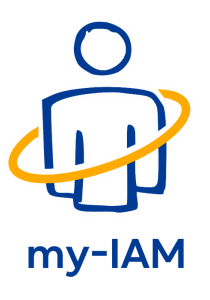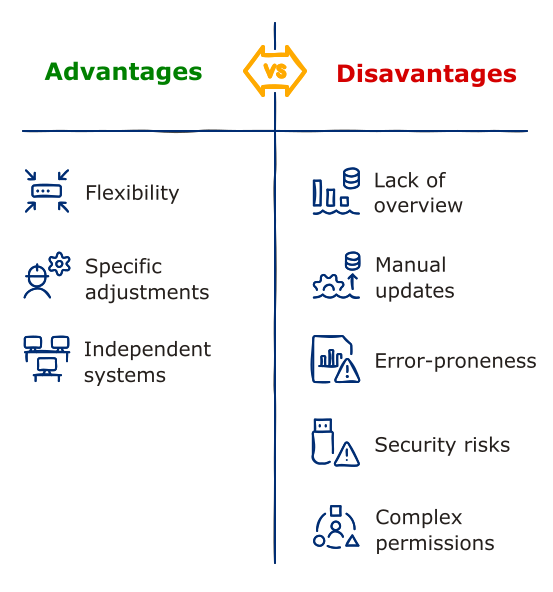Identity management: overcoming the challenges of contact integration
Identity management plays a central role in the automated contact integration within companies. Contact information is essential for internal processes and collaboration with customers, partners, and suppliers. However, these data are often spread across multiple systems, making them difficult to use and leading to errors and security risks.
The solution to this problem lies in modern distributed identity management (IAM). With a solution like RealIdentity , companies can synchronize their contact data in real time across all systems – quickly, securely, and error-free. Learn how this technology optimizes your data management and increases efficiency.
Index
Identity management and automated contact integration
Why does identity management play a central role in automated contact integration?
The data of external partners, customers, or suppliers are often managed in separate systems.
For example, a customer provides a new address that is updated in the purchasing department but does not reach the accounting software. This can lead to invoices being sent to outdated addresses, causing delays and additional costs. The distribution of contact data across platforms like Entra ID, CRM systems, or HR applications results in a lack of central oversight. When an employee leaves the company or a customer updates their contact information, the change often has to be manually recorded in all systems.
Such processes are not only inefficient, but they also carry the risk of outdated or incorrect data circulating. At the same time, IT departments struggle to make access to this data secure and traceable. Permissions must be defined not only for individual systems but also for their integration. This is a task that becomes increasingly complex as the number of applications grows.
Identity management without automated contact integration
Why do outdated methods fail in data maintenance?
Comparison of classic vs. modern identity management: An overview
| Classic data management | Distributed IAM (e.g., RealIdentity) |
| Manual maintenance in multiple systems | Automatic real-time synchronization |
| High error susceptibility | Uniform, consistent data |
| Security gaps due to inconsistent permissions | Detailed access control per user & system |
| Time- and cost-intensive | Efficient and low-maintenance processes |
Outdated methods of data maintenance and permission management present significant risks when managing contact data. Many companies rely on manual processes, where contact information for employees, partners, or suppliers is maintained in different systems. This approach often leads to inconsistencies and incomplete records, which are both inefficient and can severely hinder business processes. When contact data is not centrally and up-to-date, numerous problems arise in practice, directly affecting collaboration and operational security.
Problems with manual contact data maintenance:
- High time investment for manual updates
- Incorrect or outdated data leads to misunderstandings
- Orders or invoices are sent to incorrect addresses
- Lack of synchronization between CRM, Entra ID, and other systems
- Security risks due to unclear permission assignments
Do you face similar challenges? Discover how an automated solution like RealIdentity can free your company from manual processes and simplify data maintenance.
A common scenario is working with external partners. If their contact data is not updated in real time, projects and communication can go astray, leading to delays. Outdated data can also cause misunderstandings and weaker customer relationships.
Outdated data also jeopardizes compliance with data protection regulations, such as the GDPR. Companies that do not use a centralized, automated solution struggle to meet legal requirements and minimize risks.
Overall, it is clear that manual approaches do not meet the needs of modern businesses. Centralized, automated management is essential to ensure efficiency, security, and compliance.
Requirements for modern Identity Management
What requirements must companies place on modern identity management? Companies of all kinds need solutions that systematically address these issues. Identity management is key to ensuring seamless integration and updating of contact data across systems. The most important requirement is automation. Systems must be able to synchronize data from different sources in real time. A change in one system should be immediately visible in all connected applications. At the same time, a high level of security must be ensured. Permissions must not be granted indiscriminately but should be tailored to the individual needs.
Another requirement is integration with existing applications. Companies cannot afford to overhaul their entire infrastructure to introduce a new solution. A modern system must seamlessly integrate with existing platforms like Microsoft Teams, Outlook, or CRM systems. This ensures user acceptance, as users still want to work within their familiar systems.
Why distributed IAM is the future of data integration
Distributed identity and permission management provides a forward-thinking approach to the effective management of contact and user data. Instead of storing data centrally, it is managed and provided as needed in a decentralized manner. This approach reduces dependence on individual systems and also offers greater flexibility. Companies can continue to use their existing platforms while benefiting from the advantages of modern identity management.
Distributed IAM allows changes to be automatically transferred to all systems. This ensures that the data is always up-to-date and consistent. At the same time, companies can precisely control access rights. Employees are granted only the permissions they need for their work. The risk of excessive permissions and security gaps is minimized.
RealIdentity: The Solution for Modern Data Management
The SaaS solution my-IAM RealIdentity addresses exactly these points. In all critical systems, correct and up-to-date contact information must be available in real time. RealIdentity uses the latest identity management to enable seamless integration and management of contact data from various systems such as Entra ID, CRM, and HR applications. The platform’s Real-Talk technology makes changes instantly visible across all connected systems.
Companies do not need to replace their existing systems to use RealIdentity. Instead, my-IAM RealIdentity integrates data through standardized interfaces. This allows users to continue working in their familiar applications while the synchronization happens in the background. For example, a company plans the implementation of a central contact directory. The required data is stored in Entra ID and a CRM system. RealIdentity consolidates this data and synchronizes it with the new application. The source systems automatically mirror changes, ensuring the data is always up to date.
For example, my-IAM RealIdentity pulls contact data from a CRM system and Entra ID, processes it, and makes it available for a third-party application, such as an organizational directory:
Handling Large Volumes of Data with RealIdentity
RealIdentity’s strength becomes particularly evident when handling large volumes of data. Companies with large amounts of contact data, which can amount to millions, benefit from the high performance of my-IAM RealIdentity, which consolidates large data sets in a short amount of time. Furthermore, RealIdentity supports not only person identities but also groups and other objects like rooms, vehicles, or devices. This flexibility allows it to cover a wide range of use cases.
The SaaS solution also ensures a high level of security. Through flexible role assignment, companies can ensure that only authorized users have access to sensitive data. At the same time, RealIdentity reduces administrative overhead by automating many processes. The result is more efficient workflows and enhanced data security.
Who Benefits from Distributed Identity Management?
Distributed Identity and Access Management is especially useful for companies using multiple systems and platforms, working with external partners, or facing high security requirements. It enables efficient and secure management of identity and access data without fundamentally altering the existing infrastructure.
Self-reflection Questions:
- Do you work in a company with multiple platforms and systems (e.g., CRM, HR, email, Microsoft Teams)?
- Do you regularly work with external partners or suppliers whose contact data and access rights need to be updated?
- Do you struggle to ensure the consistency and currency of identity data across different departments or systems?
- Are you facing security risks such as inaccurate permissions or excessive access to sensitive data?
- Is compliance with privacy and data protection regulations such as the GDPR a key concern for your company?
If you answered “Yes” to one or more of these questions, distributed identity management could be a valuable solution for your company.
Conclusion: Efficient Contact Integration as the Key to Digitalization
Integrating contact data into third-party software is a key challenge for businesses. With solutions like RealIdentity, this data can be efficiently managed and securely utilized. my-IAM RealIdentity combines flexibility, security, and automation, enabling companies to use their contact data as a strategic resource. At the same time, companies save time by eliminating unnecessary tasks related to contact data maintenance and errors that could ultimately lead to lost orders and trust with customers.
More About the my-IAM Platform





